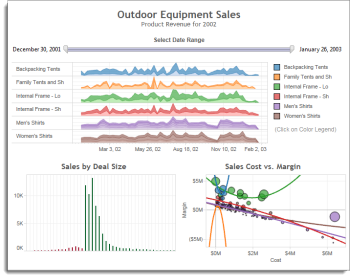Amazon Redshift and Tableau: Days, not Months, to ROI
When you start measuring big data project completion in hours and minutes, you know you're onto something. Amazon Redshift is turning the big data world on its head by allowing anyone to create a fully managed cloud-based data warehouse in minutes. Layer on top of this the ability to directly connect Tableau to Redshift clusters in just a few clicks and you've got a petabyte-scale enterprise data infrastructure that any business user can get visual analytic answers from quickly and easily.
The speed on both sides is really the magic. Take this scenario for example:
Your organization is getting crushed by big data. The more data you keep the more frustrated your business users get with queries that take hours-if not days. The more you try to improve the data ecosystem the more money you invest in both hardware and specialized resources.

You're a small to medium sized shop which means everyone is watching the budget all the time. ROI matters and recognizing it sooner rather than later is not just a good thing...it's a necessary thing.
Considering the problem and the size of your organization, many enterprise level big data and data warehousing solutions just aren't a possibility, given time, money and people constraints. Presenting a solution to management that specs out huge dollar amounts for implementation and maintenance, will take months to complete and adds the necessity of additional head count...well...let's face it...that proposal is dead before the end of the second slide.
And oh yeah, we haven't even touched on how your business users are going to access the warehoused data yet. Specialized report writers? Pre-canned dashboards? None of those is going to be acceptable since neither is cost effective or scalable given your team's bandwidth.
This is where the Amazon Redshift + Tableau 1-2 punch comes in. Spinning up a Redshift cluster takes just a few minutes and lets you offload the constraints of scalability and management to Amazon Web Services' infrastructure. Once you're up and running with Redshift, connecting Tableau to your new cloud-based data warehouse requires just nine clicks and four fields (Don't believe me? Watch the video on the solutions page and see for yourself). At that point your Redshift data warehouse is open for business and any user with the right credentials can start taking full advantage of your organization's data.

With the entire might of the Amazon Web Service cloud infrastructure backing your Redshift instance and Tableau giving your users unparalleled analytic freedom on the front end, crunching through massive data sets and discovering business insights has never been easier. Big data goes from being an obstacle to an asset, literally overnight.
To learn more about the integration between Amazon Redshift and Tableau, check out our new solutions page that includes two new video demonstrations as well as a live interactive visualization.
Subscribe to our blog
Ontvang de nieuwste updates van Tableau in je inbox.



